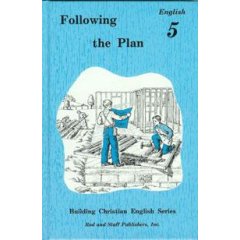The Building Christian English series for grades two through ten is excellent for those who prefer a formal academic approach and don’t need any fluff. Comprehensive coverage, clear explanations, examples, and plenty of practice provide a solid, if unexciting, foundation in the language arts. A great deal of scriptural content, as well as frequent references to farm life, also serve to differentiate this program’s content from most others. Some of the examples and writing assignments reflect the Mennonite lifestyle of this series' publisher so strongly that non-Mennonite children might have trouble relating to them. Despite these possible drawbacks, instruction in grammar and other language arts is better than in most other programs.
Books are all hardbound, printed in black-and-white with minimal illustrations. Children do not write in the textbooks, so they can be reused. But that means that students need to write their answers and compositions in a notebook. The teacher’s manuals include teaching instructions plus answers to student exercises. Lessons require teacher involvement and allow for some independent work, increasing the latter at higher grade levels.
Like other classroom-designed texts, these books include extra busywork for classroom purposes, so it is not necessary for children to do all exercises. Both oral and written exercises are included within each lesson. The amount of writing might be too much for some students, especially at the younger levels. If this is the case, more exercises can be done orally or skipped altogether.
Original composition work is included, but there is a minimal amount in comparison to other written exercises until students reach ninth and tenth grades. Answers, oral reviews, and written quizzes are in the teacher’s manuals.
For grades three through eight there is a set of extra worksheets. Grades two through eight have test booklets. Tests are combined with editing worksheets for grades nine and ten. While worksheet sets are essential for levels nine and ten, for other levels they provide additional work rather than serve as the primary source of student exercises.
Building Christian English 2, Preparing to Build
In keeping with its subtitle, this book lays the groundwork by providing substantial work in both composition and grammar. Coverage is very broad and comprehensive for a second-grade text. Composition work includes basic sentence structure up through paragraph development and writing poetry. Grammar includes parts of speech (nouns, verbs, pronouns, and adjectives) and usage. Other chapters work on alphabetical order, dictionary use, synonyms, antonyms, and homonyms. Diagramming is not introduced until the third grade.
Building Christian English 3, Beginning Wisely
This level introduces nouns, pronouns, verbs, adjectives, and adverbs as well as noun usage as subjects and direct objects. Diagramming is taught along with each part of speech. Dictionary work, capitalization, punctuation, and oral communication are also taught. At this level, the teacher’s manual states that the worksheets, oral reviews, and written quizzes are not required for the course.
Building Christian English 4, Building with Diligence
The grade four text includes all basic parts of speech except interjections, along with diagramming. Original composition writing is included, but it teaches within limited patterns reflecting Rod and Staff’s educational philosophy—the emphasis is on organization and clear writing rather than upon creativity. There are many student exercises in the textbook, so it is unnecessary to purchase the extra worksheets with even more exercises.
Building Christian English 5, Following the Plan
This comprehensive text covers the eight basic parts of speech, writing skills, speaking and listening.
Building Christian English 6, Progressing with Courage
This text reviews and expands upon previous levels. There is a heavy emphasis upon grammar. It might be too detailed for some students, but Rod and Staff’s comprehensive grammar coverage in elementary grades allows students to concentrate on other language skills in high school if they master grammar by the end of eighth grade. Composition, listening, reading, and speaking skills are also taught.
Building Christian English 7, Building Securely
English 7 covers grammatical concepts that other publishers spread out through high school, so this text is more difficult and more comprehensive than most others for seventh grade. While that might be fine for some students, it might be too detailed or have too much busywork for others. Using the exercises selectively helps overcome such problems.
Building Christian English 8, Preparing for Usefulness
This book reflects the shift from learning grammar to applying it. The remaining elements of grammar are covered, but more importantly, students work with many forms of written communication.
Building Christian English 9 and 10, Communicating Effectively, Books One and Two
By high school, students have thoroughly studied grammar, so the emphasis shifts toward composition and speech. For the most part grammar and mechanics are reviewed, although a few more-complex grammatical concepts are taught. Chapters alternate between grammar and composition/speech. Even then, grammar chapters all have subsections on “Improving Your Writing Style,” “Improving Your Editing Skills,” or “Improving Your Speaking Style”—students are continually working to improve writing and speaking skills.
These two books were written with much in common so that either can be used first. Book One covers outlining, arguments, writing book reports, character sketches, letter writing, and poetry while Book Two covers descriptive essays, expository essays, bibliographies and footnotes, parliamentary procedure, and story writing.
Summary
I appreciate the fact that Rod and Staff is one of the rare publishers that recognizes that grammar skills can be mastered in fewer than twelve years.









